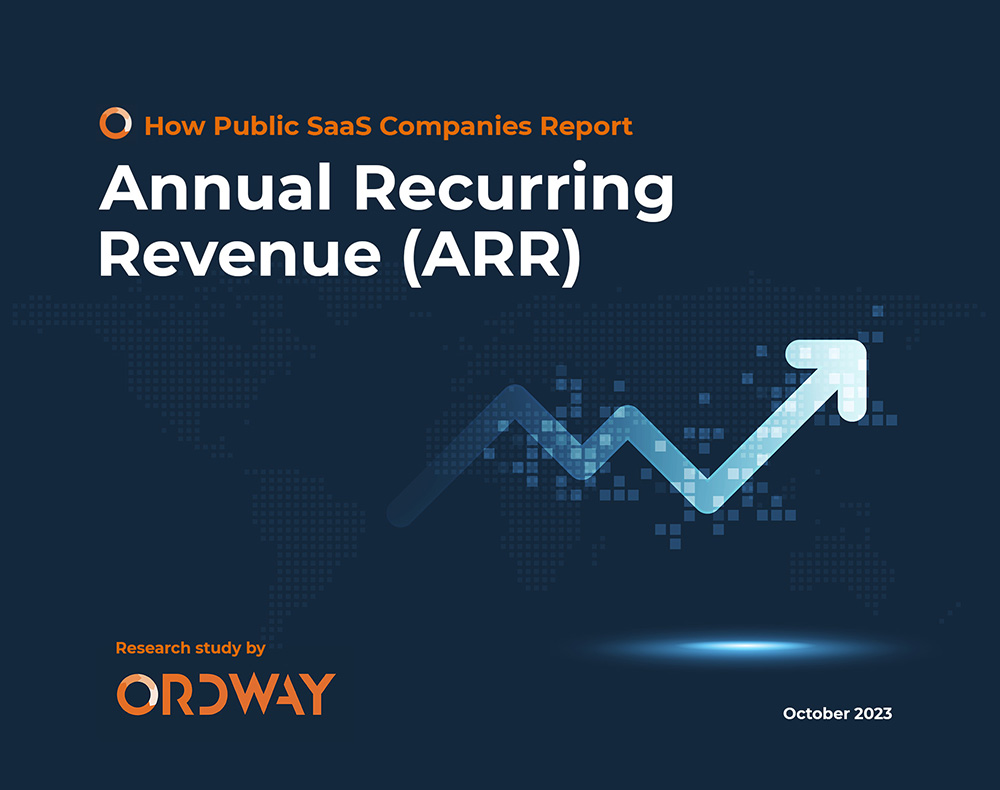Latest report – published in October 2023
100+ SaaS and Cloud Companies Analyzed
How they define and calculate ARR
To gain insights into how publicly traded companies report on and define Annual Recurring Revenue (ARR), Ordway conducted an analysis of financial disclosures from companies listed on US capital markets. In total, we reviewed 136 actively listed SaaS, cloud, and fintech providers on the NYSE and NASDAQ. The analysis included US-based companies as well as foreign issuers.
Download the Research Study

60-Page Report Includes
- Reporting on ARR results
- Use of ARR for net retention
- Current, contracted monthly price x 12
- Total contract value / contract length
- Annualized GAAP revenue
- Month-to-month, pay-as-you-go accounts
- Usage-based pricing fees
Summary of Research Findings
Research Findings
Public SaaS Company Reporting on ARR
- Referenced ARR – 82 of the 136 referenced ARR (or a variant) in their investor filings. ARR is referenced in a variety of contexts including key business metrics, total addressable market, executive compensation, and credit arrangements.
- Defined ARR – 69 of the 136 defined ARR. Sometimes ARR is only referenced in the context of calculations of other key business metrics. For example, about 25 companies only mentioned ARR in the context of calculating Net Revenue Retention or tracking the number of accounts with greater than $100K or $1M ARR.
- Reported ARR – 40 of the 136 reported ARR results. Companies that referenced ARR and reported it as a key business metric in the Management’s Disclosure & Analysis section of their annual report. These organizations also reported annual ARR results for the past few fiscal years.
Policy Elections
Products and Customer Segments Included
- Customer Segments – Just because a customer may have a recurring revenue contract does not mean it is included in ARR calculations. Some SaaS companies purposefully excluded consumer or small business segments from ARR reporting due to the higher churn.
- Contract Lengths – Some include monthly, pay-as-you-go plans in ARR calculations while other SaaS providers only include customers with formal contracts of 12 months in length or greater.
- Deployment Models – Products do not need to be run on a cloud platform, nor do they need to be delivered “as-a-service” to be included in ARR. Recurring revenue generated from “self-managed” technology run in a private cloud or “on-premise” is often included in ARR. Maintenance fees associated with perpetual licenses are also reported as ARR.
Key Findings
Methods for Calculating ARR
Methods for calculating ARR vary amongst public SaaS and cloud companies. We identified three common models – each of which rely on calculating a monthly run rate first (e.g. MRR), which is then annualized.
In the first model, MRR is “assigned” to each customer. Finance reviews the current monthly price for products with recurring revenue in the contract and then annualizes it. For example, suppose a SaaS customer had a 12-month contract with pricing of $100 per user per month for 20 users. The current MRR is $2,000 ($100 x 20), resulting in an ARR of $24,000 ($2,000 x 12).
Ordway SaaS Metrics Reporting
Ordway enables SaaS and cloud companies to report on metrics such as annual recurring revenue (ARR), average revenue per user (ARPU), new bookings, expansions, renewals, churn, gross revenue retention (GRR), and net revenue retention (NRR).


